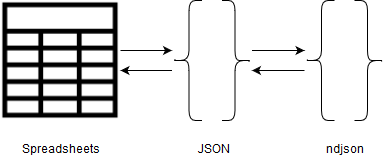gulp-etl-tap-spreadsheet v1.0.3
gulp-etl-tap-spreadsheet
This plugin converts spreadsheet files (currently tested on xlsx, xls, csv, dbf, ods, txt and html) to gulp-etl Message Stream files. This plugin is a wrapper for xlsx.
This diagram shows the flow of this program. It takes a spreadsheet, converts it to a JSON, and uses that to create the message streams saved as a ndjson file, described as down below

This is a gulp-etl plugin, and as such it is a gulp plugin. gulp-etl plugins work with ndjson data streams/files which we call Message Streams and which are compliant with the Singer specification. In the gulp-etl ecosystem, taps tap into an outside format or system and convert their contents/output to a Message Stream, and targets convert/output Message Streams to an outside format or system. In this way, these modules can be stacked to convert from one format or system to another, either directly or with tranformations or other parsing in between. Message Streams look like this:
{"type": "SCHEMA", "stream": "users", "key_properties": ["id"], "schema": {"required": ["id"], "type": "object", "properties": {"id": {"type": "integer"}}}}
{"type": "RECORD", "stream": "users", "record": {"id": 1, "name": "Chris"}}
{"type": "RECORD", "stream": "users", "record": {"id": 2, "name": "Mike"}}
{"type": "SCHEMA", "stream": "locations", "key_properties": ["id"], "schema": {"required": ["id"], "type": "object", "properties": {"id": {"type": "integer"}}}}
{"type": "RECORD", "stream": "locations", "record": {"id": 1, "name": "Philadelphia"}}
{"type": "STATE", "value": {"users": 2, "locations": 1}}Usage
gulp-etl plugins accept a configObj as the first parameter, and sheetOpts is an optional second parameter. The configObj is the "Parsing Options" object for xlsx described here. The sheetOpts are the options for generating a JSON object with xlsx described here. If a file has multiple sheets, they will be exported to a single file with the stream name indicating the sheet name. The exported file will be a ndjson file.
If HTML and TXT files are exported from excel they will import properly. Otherwise, HTML tables must be a simple format of having a header for every column, containing the columns name.
Sample gulpfile.js
var gulp = require("gulp");
var tapSpreadSheet = require("./src/plugin").tapSpreadSheet;
function runTapSpreadSheet(callback) {
return gulp
.src(["./testdata/*", "!./testdata/ignore", "!./testdata/processed"])
.pipe(tapSpreadSheet({ type: "buffer" }, { raw: false }))
.pipe(gulp.dest("./testdata/processed"));
}
exports["default"] = gulp.series(runTapSpreadSheet);Quick Start for Coding on This Plugin
- Dependencies:
- Clone this repo and run
npm installto install npm packages - Debug: with VScode use
Open Folderto open the project folder, then hit F5 to debug. This runs without compiling to javascript using ts-node - Test:
npm testornpm t - Compile to javascript:
npm run build - Run default task :
npm run defaultTask
Testing
We are using Jest for our testing. Each of our tests are in the test folder.
- Run
npm testto run the test suites
Note: This document is written in Markdown. We like to use Typora and Markdown Preview Plus for our Markdown work.. This document utilalized embedme in order to embed code into readme